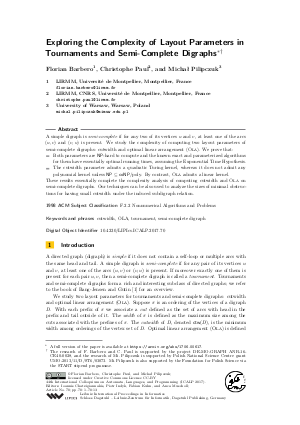Exploring the Complexity of Layout Parameters in Tournaments and Semi-Complete Digraphs
Authors Florian Barbero, Christophe Paul, Michal Pilipczuk
-
Part of:
Volume:
44th International Colloquium on Automata, Languages, and Programming (ICALP 2017)
Part of: Series: Leibniz International Proceedings in Informatics (LIPIcs)
Part of: Conference: International Colloquium on Automata, Languages, and Programming (ICALP) - License:
 Creative Commons Attribution 3.0 Unported license
Creative Commons Attribution 3.0 Unported license
- Publication Date: 2017-07-07
File

PDF
LIPIcs.ICALP.2017.70.pdf
- Filesize: 0.52 MB
- 13 pages
Document Identifiers
Subject Classification
Keywords
- cutwidth
- OLA
- tournament
- semi-complete digraph
Metrics
- Access Statistics
-
Total Accesses (updated on a weekly basis)
0Document
0Metadata
Abstract
A simple digraph is semi-complete if for any two of its vertices u and v, at least one of the arcs (u,v) and (v,u) is present. We study the complexity of computing two layout parameters of semi-complete digraphs: cutwidth and optimal linear arrangement (OLA). We prove that: -Both parameters are NP-hard to compute and the known exact and parameterized algorithms for them have essentially optimal running times, assuming the Exponential Time Hypothesis. - The cutwidth parameter admits a quadratic Turing kernel, whereas it does not admit any polynomial kernel unless coNP/poly contains NP. By contrast, OLA admits a linear kernel. These results essentially complete the complexity analysis of computing cutwidth and OLA on semi-complete digraphs. Our techniques can be also used to analyze the sizes of minimal obstructions for having small cutwidth under the induced subdigraph relation.
Cite As Get BibTex
Florian Barbero, Christophe Paul, and Michal Pilipczuk. Exploring the Complexity of Layout Parameters in Tournaments and Semi-Complete Digraphs. In 44th International Colloquium on Automata, Languages, and Programming (ICALP 2017). Leibniz International Proceedings in Informatics (LIPIcs), Volume 80, pp. 70:1-70:13, Schloss Dagstuhl – Leibniz-Zentrum für Informatik (2017)
https://doi.org/10.4230/LIPIcs.ICALP.2017.70
BibTex
@InProceedings{barbero_et_al:LIPIcs.ICALP.2017.70,
author = {Barbero, Florian and Paul, Christophe and Pilipczuk, Michal},
title = {{Exploring the Complexity of Layout Parameters in Tournaments and Semi-Complete Digraphs}},
booktitle = {44th International Colloquium on Automata, Languages, and Programming (ICALP 2017)},
pages = {70:1--70:13},
series = {Leibniz International Proceedings in Informatics (LIPIcs)},
ISBN = {978-3-95977-041-5},
ISSN = {1868-8969},
year = {2017},
volume = {80},
editor = {Chatzigiannakis, Ioannis and Indyk, Piotr and Kuhn, Fabian and Muscholl, Anca},
publisher = {Schloss Dagstuhl -- Leibniz-Zentrum f{\"u}r Informatik},
address = {Dagstuhl, Germany},
URL = {https://drops.dagstuhl.de/entities/document/10.4230/LIPIcs.ICALP.2017.70},
URN = {urn:nbn:de:0030-drops-74537},
doi = {10.4230/LIPIcs.ICALP.2017.70},
annote = {Keywords: cutwidth, OLA, tournament, semi-complete digraph}
}
Author Details
References
-
Jørgen Bang-Jensen and Gregory Gutin. Digraphs - theory, algorithms and applications. Springer, 2002.

-
Daniel Binkele-Raible, Henning Fernau, Fedor V. Fomin, Daniel Lokshtanov, Saket Saurabh, and Yngve Villanger. Kernel(s) for problems with no kernel: On out-trees with many leaves. ACM Transactions on Algorithms, 8(4):38, 2012.

-
Maria Chudnovsky, Alexandra Fradkin, and Paul Seymour. Tournament immersion and cutwidth. Journal of Combinatorial Theory, Series B, 102(1):93-101, 2012.

-
Maria Chudnovsky and Paul Seymour. A well-quasi-order for tournaments. Journal of Combinatorial Theory, Series B, 101(1):47-53, 2011.

-
Marek Cygan, Fedor V. Fomin, Łukasz Kowalik, Daniel Lokshtanov, Dániel Marx, Marcin Pilipczuk, Michał Pilipczuk, and Saket Saurabh. Parameterized Algorithms. Springer, 2015.

-
Rodney G. Downey and Michael R. Fellows. Fundamentals of Parameterized Complexity. Texts in Computer Science. Springer, 2013.

-
Andrew Drucker. New limits to classical and quantum instance compression. SIAM journal of Computing, 44(5):1443-1479, 2015.

-
Fedor V. Fomin and Michał Pilipczuk. Subexponential parameterized algorithm for computing the cutwidth of a semi-complete digraph. In ESA 2013, volume 8125 of Lecture Notes in Computer Science, pages 505-516. Springer, 2013.

-
Alexandra Fradkin. Forbidden structures and algorithms in graphs and digraphs. PhD thesis, Princeton University, 2011.

-
Alexandra Ovetsky Fradkin and Paul D. Seymour. Edge-disjoint paths in digraphs with bounded independence number. Journal of Combinatorial Theory, Series B, 110:19-46, 2015.

-
Valentin Garnero and Mathias Weller. Parameterized certificate dispersal and its variants. Theoretical Computer Science, 622:66-78, 2016.

-
Archontia C. Giannopoulou, Michał Pilipczuk, Jean-Florent Raymond, Dimitrios M. Thilikos, and Marcin Wrochna. Cutwidth: obstructions and algorithmic aspects. CoRR, abs/1606.05975, 2016. To appear in Proceedings of IPEC 2016.

-
Danny Hermelin, Stefan Kratsch, Karolina Sołtys, Magnus Wahlström, and Xi Wu. A completeness theory for polynomial (Turing) kernelization. Algorithmica, 71(3):702-730, 2015.

-
Russell Impagliazzo, Ramamohan Paturi, and Francis Zane. Which problems have strongly exponential complexity? Journal of Computer and System Sciences, 63(4):512-530, 2001.

-
Bart M. P. Jansen. Turing kernelization for finding long paths and cycles in restricted graph classes. Journal of Computer and System Sciences, 85:18-37, 2017.

-
Michał Pilipczuk. Computing cutwidth and pathwidth of semi-complete digraphs via degree orderings. In STACS 2013, volume 20 of LIPIcs, pages 197-208. Schloss Dagstuhl - Leibniz-Zentrum für Informatik, 2013.

-
Michał Pilipczuk. Tournaments and optimality: new results in parameterized complexity. PhD thesis, University of Bergen, Norway, 2013.

-
Alexander Schäfer, Christian Komusiewicz, Hannes Moser, and Rolf Niedermeier. Parameterized computational complexity of finding small-diameter subgraphs. Optimization Letters, 6(5):883-891, 2012.

-
Thomas J. Shaefer. The complexity of satisfiability problems. In STOC 1978, pages 216-226. ACM, 1978.

-
Robin Thomas. A menger-like property of tree-width: the finite case. Journal of Combinatorial Theory Series B, 48(1):67-76, 1990.

-
Stéphan Thomassé, Nicolas Trotignon, and Kristina Vušković. A polynomial Turing-kernel for Weighted Independent Set in bull-free graphs. Algorithmica, 77(3):619-641, 2017.

